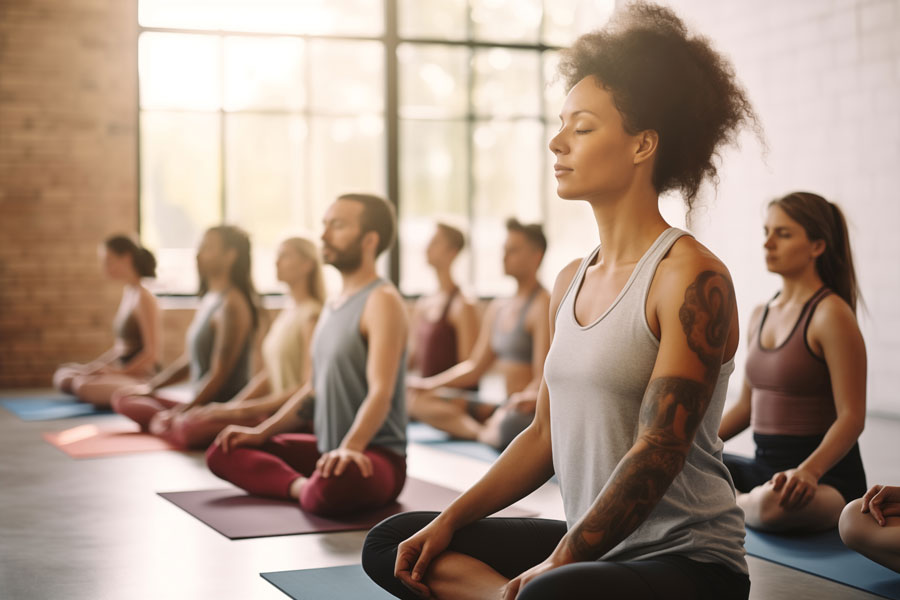Yoga Breathing Techniques for Stress Reduction and Mental Clarity

Stress and mental fog are all too common in our fast-paced society, and they frequently lower our productivity and general quality of life.
With its long history and centuries-old practices, the discipline of yoga provides a remedy in the shape of a variety of breathing exercises created especially to address these problems.
We can access a multitude of advantages, such as reduced stress and improved mental clarity, by paying attention to and controlling our breath—a basic but frequently disregarded part of our health.
The fascinating aspects are how these various methods function, the science underlying their efficacy, and the useful ways in which we may apply them to our everyday lives.
What Is Yogic Breathing?
Yogic breathing, a cornerstone of yoga practices, is a deliberate and controlled method of inhaling and exhaling through the nose, designed to gather prana, or energy, and sharpen focus, thereby calming the nervous system and enhancing mindfulness. The benefits of yogic breathing for stress reduction are well-documented, with numerous scientific studies exploring its calming effects.
Incorporating yogic breathing into daily life can be achieved through several techniques. Deep belly breathing, box breathing, and alternate nostril breathing are all styles that can be practiced anywhere, anytime. Each has unique benefits, including fostering mental clarity, focus, and a sense of inner peace.
Deep belly breathing uses the diaphragm for maximum lung expansion, encouraging a sense of calm and relaxation. Box breathing, on the other hand, helps slow down the mind and reduce anxiety, while alternate nostril breathing can balance energy levels and promote a sense of well-being.
To experience the full benefits, it is important to practice regularly. Through consistent practice, yogic breathing can become a comforting and grounding routine, providing a haven of calm in today’s hectic world. Embrace the journey and welcome the peace that yogic breathing brings.
The Art of Yogic Breathing: 4 Techniques to Transform Your Practice

Three-part breath (Dirga Pranayama)
Delving into the realm of yoga breathing techniques, one encounters the calming practice of the Three-part breath (Dirga Pranayama). This deep breathing exercise involves inhaling and exhaling in three distinct parts: the belly, ribcage, and upper chest. It’s a powerful technique for relaxation, enhancing mindfulness, and stress relief. By focusing on each part, you improve mental focus, creating an intimate connection with your breathwork.
Benefits | Details |
Stress Relief | Regular practice reduces tension and anxiety |
Mindfulness | Enhances present moment awareness |
Mental Clarity | Promotes concentration and focus |
Alternate nostril breathing (Nadi Shodhana)
Extending the meditative benefits of the Three-part breath, another important yoga method to think about is Alternate nostril breathing, or Nadi Shodhana. This is a very important activity that provides a special harmony of energy and calm.
Sitting comfortably and breathing deliberately through each nostril are the first steps in practicing alternating nostril breathing.
You can investigate variations of alternate nostril breathing to enhance your practice and give it a deeper meaning.
Including alternative nostril breathing in your regular yoga practice helps you feel calmer and more emotionally balanced.
The usefulness of alternate nostril breathing in reducing nervous system activity and improving mental clarity has been demonstrated by scientific research.
This effective method can enhance your path to reduced stress and sharper focus.
Lion’s breath (Simhasana)
Have you ever tried the Lion’s breath (Simhasana), an invigorating yogic breathing technique designed to relieve tension and enhance mindfulness? Exploring the lion’s breath technique reveals its power in reducing stress and providing anxiety relief. Incorporating lion’s breath into your daily routine is simple and can yield significant mental and physical benefits.
Breathing Exercises | Benefits | Techniques |
Lion’s Breath | Relieves tension, enhances mindfulness | Inhale deeply, stick out tongue, exhale forcefully |
Deep Breathing | Reduces anxiety, promotes relaxation | Inhale deeply, focus on the rise and fall of your breath |
Breath Focus | Improves concentration, increases calmness | Visualize peace as you inhale, release stress as you exhale |
Ocean breath (Ujjayi)
While the lion’s breath technique offers a potent method for releasing tension, another equally effective yogic breathing technique, known as Ocean breath or Ujjayi, provides additional benefits, particularly in regulating body temperature, strengthening the lungs, and enhancing mental clarity.
The Ujjayi technique involves constricting the back of the throat while breathing in and out through the nose, creating a soothing sound reminiscent of ocean waves. Ujjayi benefits extend to:
- Regulating body temperature
- Strengthening the lungs
- Enhancing mental clarity and focus
With Ujjayi for relaxation, it’s possible to achieve a calm, focused state. Various Ujjayi variations can be explored to find the one most beneficial for you.
The journey towards well-being is inclusive and empathetic, and the practice of Ujjayi techniques serves as a route towards this destination.
The Connection Between Yoga and Breathing
In the practice of Yoga, there is a profound connection between the art of controlled, deliberate breathing and the attainment of mental tranquility, demonstrating that breath is not only a physical act but also a tool for enhancing focus and gathering energy.
Yoga breathing and stress management are intrinsically linked, offering a practical solution to integrate into your daily life.
The science behind yoga breathing techniques reveals a powerful mind-body connection. When breath control is applied, a surge of oxygen flows to the brain, providing mental clarity, reducing stress, and fostering a sense of inner peace.
Below is a visual representation of the connection between yoga and breathing:
Technique | Purpose | Outcome |
Deep belly breathing | Maximizes lung expansion | Promotes relaxation |
Box breathing | Slows mind, reduces anxiety | Calming effect |
Alternate nostril breathing | Improves mindfulness | Calms the nervous system |
Breath retention | Aids relaxation | Stress reduction |
Harnessing the power of yoga breathing techniques can transform your stress management approach and provide you with a greater sense of belonging to your own mind and body. The path to mental clarity and tranquility is but a breath away.
Benefits of Yoga Breathing Techniques
It is impossible to overstate the important roles that yoga breathing methods play in supporting both physical and mental wellness.
Yoga breathing methods can assist activate the body’s natural relaxation response, which promotes a sense of calm and tranquillity. They are a powerful tool for lowering stress and enhancing mental clarity.
The benefits of yoga breathing are well supported by science. Focus and concentration can be increased, anxiety can be decreased, and sleep quality can be improved.
In particular, it causes a mood of calmness and relaxation by activating the parasympathetic nervous system. Yoga’s mindfulness and breath awareness techniques can help people reduce anxiety by enabling them to live more fully in the present.
Three particularly beneficial techniques include:
- Deep breathing: This technique stimulates the vagus nerve, promoting parasympathetic nervous system activation and stress reduction.
- Alternate nostril breathing: This method can enhance cardiovascular function and lower heart rate.
- Modified lion’s breath: Imagining yourself as a lion while exhaling with a ‘HA’ sound can aid in releasing tension and stress.
Should anyone avoid yogic breathing?

Yoga breathing precautions include being aware of any potential health issues and yoga breathing dangers that could have unfavorable impacts.
People with untreated hypertension, people with cardiac issues, and people with respiratory disorders including asthma or chronic obstructive lung disease should use caution.
Health Conditions | Precautions for Yogic Breathing |
Respiratory conditions | Avoid certain techniques |
Untreated hypertension | Avoid breath retention |
Heart conditions | Avoid forceful breathing |
Dizziness during practice | Seek medical advice |
Safety guidelines for yogic breathing stress the importance of consultation with a healthcare professional before beginning any new practice. If any discomfort, dizziness, or lightheadedness occurs during practice, it is essential to immediately discontinue and seek medical advice.
Yogic Breathing: A Balanced View of Its Effects and Risks
While yogic breathing techniques are known for their myriad benefits, they do carry a few potential side effects which are generally mild and rare, but important to be aware of. These potential risks may manifest as dizziness, lightheadedness, or discomfort due to overexertion or improper technique.
- Dizziness or Lightheadedness: This can be a sign of rapid breathing or hyperventilation. If you experience this, slow down your breath or resume normal breathing.
- Overexertion or Discomfort: This might occur if the techniques are performed with too much force or without proper form. Always remember that the goal is relaxation, not strain.
- Improper Technique: This can lead to adverse effects, reinforcing the need for expert guidance, especially for beginners.
Practicing under expert guidance can ensure the techniques are performed correctly, reducing the likelihood of adverse effects. If symptoms persist despite these precautions, consultation with a healthcare professional is needed.
Unlocking the Secrets of Nasal Breathing: Is It Better?
The act of nasal breathing emerges as a potent tool that not only enhances focus and energy but also calms the nervous system, thereby contributing significantly to stress reduction and mental clarity. The key benefits of nasal breathing lie in its capacity to deepen our connection with our bodies, facilitating a heightened state of mindfulness.
The nose plays a crucial role in yoga breathing, acting as a natural filtration system for the air we breathe, unlike mouth breathing which lacks this filtering mechanism.
Nasal breathing versus mouth breathing is a topic of significant discussion within the yoga community, with the former often preferred for its ability to regulate and control breath flow, augmenting the practice of yoga.
Techniques for mindful breathing, such as the lion’s breath, incorporate nasal breathing as it promotes slow, deep breaths, further calming the mind and body. The question arises then, how to incorporate nasal breathing in daily life?
It can be as simple as consciously choosing to breathe through your nose during daily tasks, or by integrating it into your yoga or meditation routine. Remember, it’s all about fostering a sense of internal tranquility and clarity.
How Do I Teach Myself to Breathe?
Mastering the art of yoga breathing requires deliberate practice and focused attention. It can be a powerful tool for reducing stress, calming the nervous system, and enhancing mindfulness. Here’s how to improve your breathing technique at home.
One, start with diaphragmatic breathing. It’s the cornerstone of yoga breathing and involves inhaling deeply into your belly, not just your chest. The benefits of deep breathing exercises are immense, including stress reduction, improved digestion, and better sleep.
Second, practice breath retention. Hold your breath for a few counts at the end of each inhale and exhale. This can help to balance your nervous system and increase your lung capacity.
Third, make it a daily routine. Incorporating breathwork into your daily routine can help anchor your day, provide moments of calm, and improve your overall well-being.
Conclusion
Yogic breathing is an effective method for promoting mental clarity and lowering stress. These methods, rooted in traditional knowledge, provide a way to improve wellbeing. Through the practice of breath awareness, people can embark on a life-changing journey toward inner peace and equilibrium.
Including these habits in everyday life can have significant advantages, promoting resilience and serenity in the face of adversity. The breath is, in fact, a powerful ally in the quest for overall wellness.



